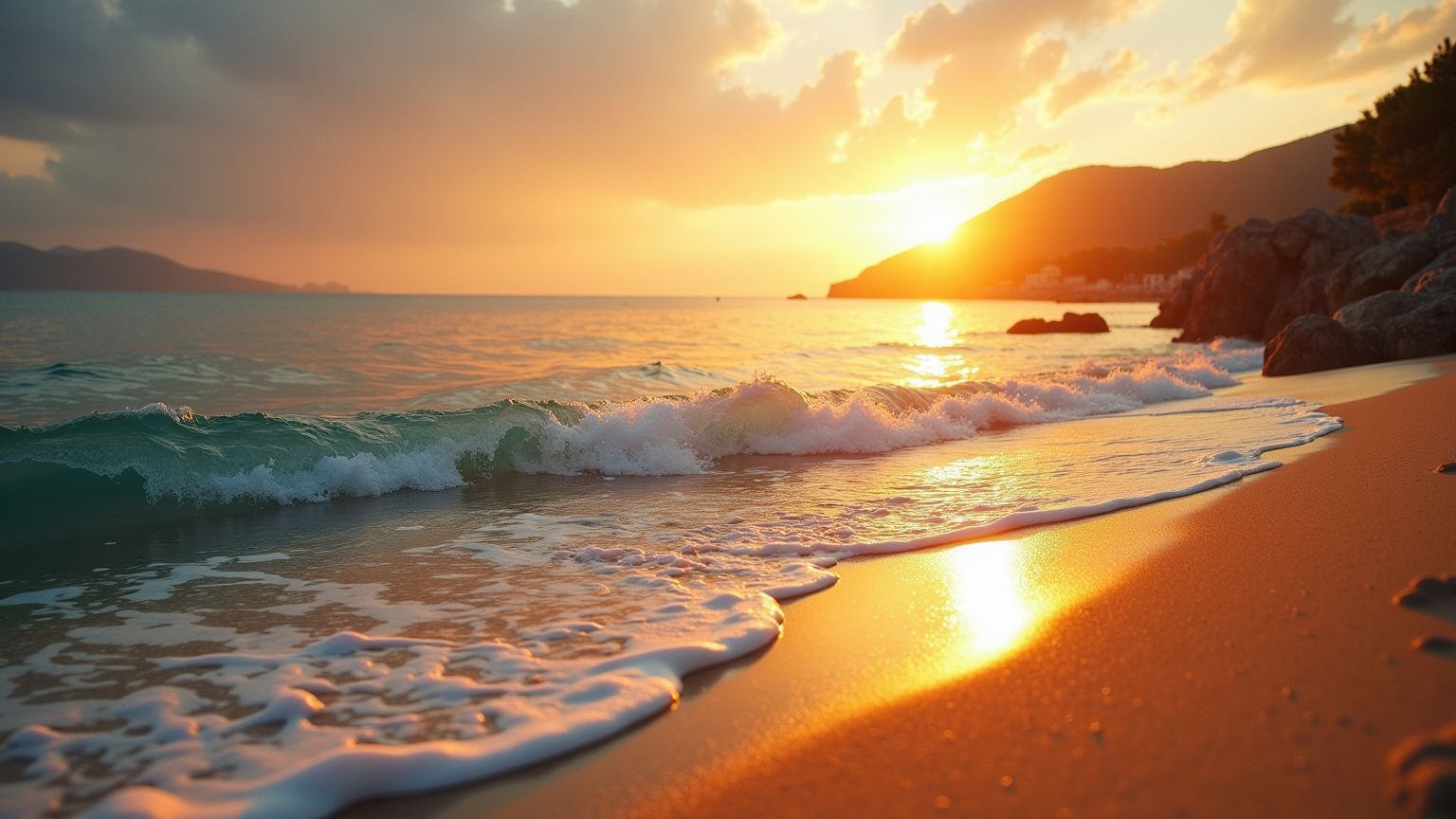Karathona Beach: Nafplio’s Secret Paradise Just Minutes Away
Barefoot on golden sand with the sun creeping over the Argolic Gulf – that's been my morning ritual for fifteen years. I watch the waters of Karathona Beach shift from inky navy to that impossible turquoise as daylight takes charge, before heading back to meet my tour groups in Nafplio.
Sure, you've probably drooled over photos of Palamidi Fortress or Nafplio's postcard-perfect alleys. But what most visitors miss is this hidden gem just 3.5 kilometers from town – Karathona Beach rivals anything you'd find island-hopping, minus the sardine-packed ferries and Instagram crowds.
Getting to Know Karathona: The Locals' Favorite Escape
Karathona Beach isn't just a pretty face – it's where Nafplio families have been building sandcastles and memories for generations. The 2.5-kilometer golden crescent hugs a sheltered bay that's basically Mother Nature's version of a swimming pool.
Pine-covered hills don't just frame those envy-inducing photos – they block nasty winds, keeping Karathona Beach's waters mirror-calm when nearby beaches look like washing machines.
I can't count how many times I've watched visitors' jaws literally drop when they first glimpse Karathona Beach. "Why isn't this in every guidebook?" they gasp, genuinely stunned that something this gorgeous lurks just 10 minutes from town. Karathona Beach maintains its under-the-radar status because most folks get hypnotized by Nafplio's Venetian charms and never venture beyond the fortress shadow.
The Journey to Karathona: Easier Than You Think
Half the joy of Karathona Beach is how blissfully simple it is to reach. From Nafplio's heart, just cruise east on the coastal road toward Tolo. After about 2 kilometers (when you start wondering "am I going the right way?"), you'll spot signs pointing right toward Karathona. The road meanders through silver-leafed olive groves and pocket-sized family farms before – boom! – that coastline reveals itself.
For the step-counters and sunrise-chasers, there's a walking path connecting Nafplio to Karathona Beach. It takes roughly 45 minutes if you're not rushing (and why would you?), following bits of the ancient route that once linked the old city to its farmlands. The morning light dancing across the Argolic Gulf from this path makes even mediocre smartphone photos look professional.
No wheels? No problem. Summer brings spotty-but-functional bus service to Karathona Beach, or grab a taxi for about €10 – basically the price of two fancy coffees for access to paradise.
A Day at Karathona: What to Expect

Karathona Beach has somehow escaped the fate of Greece's theme-park beaches. The vibe stays authentically laid-back and family-friendly. The seabed slopes away so gradually that you can walk out absurdly far before the water hits your waist – perfect for nervous swimmers or families with tiny humans.
The water clarity at Karathona Beach still makes me stop mid-stroke even after all these years. On typical mirror-calm mornings, you'll spot fish darting between your toes, and the sandy bottom creates this crazy spectrum of blues that shift with depth and light angle. I've literally seen Nordic visitors stand frozen at the water's edge, mumbling that they didn't know water could be this transparent in real life.
While Karathona Beach offers creature comforts, it hasn't surrendered to the sunbed invasion that suffocates other beaches. Yes, you'll find organized sections (€7-10 for two loungers), but there's still plenty of free real estate to throw down your beach towel without paying the sunbed mafia.
The Culinary Scene: Beyond Beach Snacks
Karathona Beach isn't serving up those sad, overpriced tourist sandwiches that taste like disappointment. The tavernas here face a tough local crowd that won't tolerate mediocrity.
"Mitsos" has been my go-to since I had baby teeth. The octopus – which old Mitsos likely wrestled from the sea that very morning – practically dissolves on your fork, dressed with nothing but local olive oil that's spicy at the back of your throat, lemon, and hand-rubbed oregano. Their Greek salads feature tomatoes so intensely flavored they'll ruin supermarket versions for you forever.
For quick bites, the beach bars serve decent sandwiches, fresh salads, and the life-sustaining Greek frappe – that frothy iced coffee that becomes more essential than oxygen during July heatwaves. Pro tip that I whisper to my tour groups: everything at Karathona Beach costs about 15-20% less than identical dishes in Nafplio's tourist center. Your wallet will thank you almost as much as your stomach.
Seasonal Changes: Karathona Through the Year
Guidebooks won't tell you how dramatically Karathona Beach transforms with the seasons. July and August bring the busiest days (though "busy" at Karathona is still "practically empty" by Santorini standards).
Visit Karathona Beach in May when wildflowers explode across the surrounding hills in patches of purple, yellow and red. The water's already swim-friendly, but you might have entire stretches of beach completely to yourself – just you and the gentle splash of waves.
September and October are Karathona Beach's secret season. The summer hordes have vanished, the sea holds its summer warmth like a hot bath, and the light turns this honey-gold quality that makes everything look like it's been subtly filtered. I often spend entire afternoons in September alternating between swimming and reading without hearing another human voice.
Even winter has its own magic at Karathona Beach. Swimming becomes a polar bear club activity (though some local yiayias swim year-round, swearing it's why they'll outlive us all). The tavernas shutter for the season, and nature reclaims the space. Watching winter storms churn the bay from your car's shelter, hands wrapped around a thermos of hot coffee, becomes an unexpected pleasure.
Beyond Sunbathing: Activities at Karathona
While many visitors come to Karathona Beach just to melt into the sand, options exist for the perpetually restless. Summer brings paddleboard and kayak rentals that let you explore hidden coves you can't reach by foot.
The rocky headlands bookending Karathona Beach offer snorkeling that would make Caribbean destinations jealous. I always keep a mask and snorkel buried in my beach bag. Even a five-minute underwater expedition can reveal octopuses playing hide-and-seek among the rocks or schools of saddled seabream that flash silver when they catch the light.
Land-lovers can tackle the hiking path that starts from the eastern end of Karathona Beach. It winds up into the hills, delivering panoramic views that justify every drop of sweat. The full circuit takes about two hours and rewards you with postcard views of Nafplio, Palamidi Fortress, and on clear days, the distant mountains of Arcadia floating on the horizon like a watercolor painting.
Practical Tips From a Local
After countless sunrise-to-sunset days at Karathona Beach, I've developed some insider knowledge:
• The magic hours are before 11 AM and after 5 PM – not just for smaller crowds but also softer, more flattering light for those vacation photos that'll make your friends back home quietly hate you
• Consider packing water shoes for exploring the rockier eastern section where the best marine life hides
• Afternoon breezes can surprise you – throw a light coverup in your bag for when you're not swimming
• During peak July-August madness, early birds catch the prime spots under the natural shade of pine trees
• The beach showers exist but they're... rustic. A spare water bottle to rinse sandy feet before climbing into your rental car can save relationships
• Karathona Beach faces west, creating sunset views that make even jaded locals stop and stare – plan to stay until dusk at least once
Conservation Efforts and Environmental Awareness
Like any paradise, Karathona Beach faces challenges from its own popularity. Growing visitor numbers have raised concerns about trash management and protecting the delicate ecosystem. Many locals (myself included) join regular beach clean-ups organized by Nafplio environmental groups.
Visitors can play beach guardian by packing out trash, avoiding single-use plastics, and respecting the fragile dune areas where native plants struggle against the odds. Those plants might not look impressive, but they're holding the entire beach system together.
The bright spot? Conservation efforts are working. Water quality tests consistently give Karathona Beach top marks, and new educational signs help visitors understand why those weird-looking plants and rocky areas matter to the health of the entire coastline.
Final Thoughts: Why Karathona Holds a Special Place
After fifteen years of calling Nafplio home and exploring beaches across Greece, I still find myself drawn to Karathona Beach almost daily like it's magnetic. There's something about that perfect blend of accessibility and raw beauty that keeps its hooks in me.
Sure, Greece has more dramatic beaches – with towering cliffs or sand so white it hurts your eyes – but few offer Karathona Beach's complete package just minutes from a historical jewel like Nafplio.
For visitors, I recommend balancing time between Nafplio's historical tours and at least one full day surrendered to Karathona Beach. The contrast between wandering through stone alleys draped with bougainvillea in the morning and floating in Karathona's crystal waters that afternoon captures Greece's dual magic – where cultural riches and natural beauty dance together perfectly.
As each tourist season fades, Karathona Beach returns to locals. Sunbeds disappear, tavernas serve their farewell meals, and the beach reclaims its winter quiet. But that special beauty remains, waiting patiently to be discovered again when the cycle restarts.
Whether it's your first Nafplio visit or you're returning to dig deeper into this magical corner of the Peloponnese, make Karathona Beach non-negotiable. It might not have Santorini's Instagram fame, but for those who discover it, Karathona Beach becomes the place we secretly wish we could keep all to ourselves.








